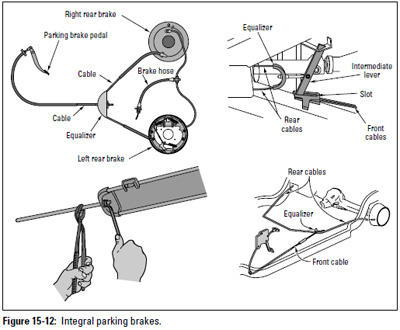These instructions for adjusting your parking brake work only if you have drum brakes on your rear wheels. If you have a manual transmission, you may have a transmission-type parking brake, which should be adjusted professionally, and parking brakes on rear-wheel disc brakes should be left to professionals, too. Your service manual may tell you which kind you have, or you can crawl under the vehicle and see for yourself. Because most people have integral parking brakes, that's the type I deal with in this section. Figure 15-12 shows you several types of integral parking brakes. They may look different, but you adjust them all the same way.
 |
Tip: You shouldn't have to pull or push the parking brake handle to the most extreme level to make the brake work. (As the cables loosen up, you have to pull the handle up higher to engage the brake.) Also, you shouldn't be able to drive the vehicle with the parking brake on. If you can, the brake needs to be adjusted or repaired. To adjust your parking brake, do the following:
- Jack up the car (a hoist would be lovely) and make sure that it's secure. Be sure to leave your parking brake off.
If you don't want to jack the car up, you can slide underneath it armed with a work light.
- Trace the thin steel cables that run from each of your rear wheels until they meet somewhere under the backseat of the vehicle.
Where they meet there should be a device (usually a bar and a screw) that controls the tension. Compare what you find with the parking brakes in Figure 15-12 to see which type you have. If you can't find the system on your vehicle in that illustration, you probably need professional help.
- Turn the screw (or whatever else you have) until the cables tighten up, and then tighten the screw nuts to hold the screw in place.
You may have to hold the cable to keep it taut (the illustration at bottom left of Figure 15-12 shows you how).
- Get out from under the vehicle and test-drive it to see whether the parking brake is working.
- Pay attention to whether the parking brake warning light on your dashboard comes on when the parking brake is engaged. If it doesn't, check or replace the bulb or fuse.
If changing the bulb or fuse doesn't work, get someone to check the connectionbetween the warning light and the brake; there may be a short in it.
From Auto Repair for Dummies, copyright © 2009 by Wiley Publishing, Inc., Indianapolis, Indiana. Used by arrangement with John Wiley & Sons, Inc.










